In regions where every drop counts, rainwater harvesting becomes an essential practice for maintaining thriving gardens. This sustainable approach not only conserves precious water resources but also provides plants with naturally soft, chemical-free water that promotes healthier growth. Whether you’re dealing with persistent drought conditions or simply want to reduce your environmental footprint, implementing a rainwater collection system can transform your gardening experience in low-rainfall areas.
This comprehensive guide will walk you through the fundamentals of rainwater harvesting specifically designed for garden irrigation in dry climates. From simple DIY setups to more advanced systems, you’ll discover practical solutions that can be tailored to your specific needs, space constraints, and budget.
Benefits of Harvesting Rainwater in Dry Climates
Harvesting rainwater in low-rainfall areas offers numerous advantages that extend beyond simple water conservation. Understanding these benefits can help you appreciate why this practice is particularly valuable in dry regions:
Environmental Benefits
- Reduces demand on municipal water supplies and groundwater
- Decreases stormwater runoff and associated pollution
- Lowers your carbon footprint by reducing energy used for water treatment
- Creates a sustainable water cycle within your property
Garden and Plant Benefits
- Provides naturally soft water free of chlorine and other chemicals
- Contains nitrogen and other nutrients beneficial for plant growth
- Helps maintain consistent soil moisture during dry periods
- Reduces salt buildup in soil common with municipal water
Practical Benefits
- Creates water independence during restrictions or shortages
- Reduces water bills, especially during peak summer months
- Provides backup water supply during emergencies
- Can be implemented at various scales to match your needs
Low-Rainfall Area Advantages
- Makes the most of limited rainfall events
- Extends growing seasons by providing water during dry periods
- Enables cultivation of plants that might otherwise struggle
- Creates microclimate benefits around collection areas
Legal and Safety Considerations
Before installing a rainwater harvesting system, it’s important to understand the legal framework and safety considerations in your area:
Legal Status of Rainwater Collection
Contrary to some misconceptions, rainwater harvesting is legal in most areas of the United States. In fact, many states and municipalities actively encourage the practice through incentives and rebate programs. However, regulations vary by location:
| Consideration | What to Check | Typical Requirements |
| Local Regulations | City or county building codes | Permits for large systems (typically over 5,000 gallons) |
| HOA Restrictions | Homeowners association bylaws | Aesthetic guidelines for visible components |
| Water Rights | State water rights laws | Volume limitations in some western states |
| Health Regulations | Local health department | Separation from potable water systems |
Safety Considerations
When implementing a rainwater harvesting system, keep these safety factors in mind:
Mosquito Prevention: In low-rainfall areas, standing water can quickly become a breeding ground for mosquitoes. Ensure all storage containers are properly sealed or screened. If using open containers, empty them within 7 days or add mosquito dunks containing Bacillus thuringiensis israelensis (BTI), a natural bacteria that prevents mosquito larvae development without harming plants.
- Child Safety: Secure large containers with locking lids to prevent accidental drowning hazards.
- Structural Considerations: Water is heavy (approximately 8 pounds per gallon), so ensure your support structures can handle the weight of full containers.
- Overflow Management: Direct overflow away from building foundations, septic systems, and neighboring properties.
- Water Quality: Use appropriate filtration if harvesting from roofs with asphalt shingles or other potentially contaminating materials.
Essential Components of a Rainwater Harvesting System
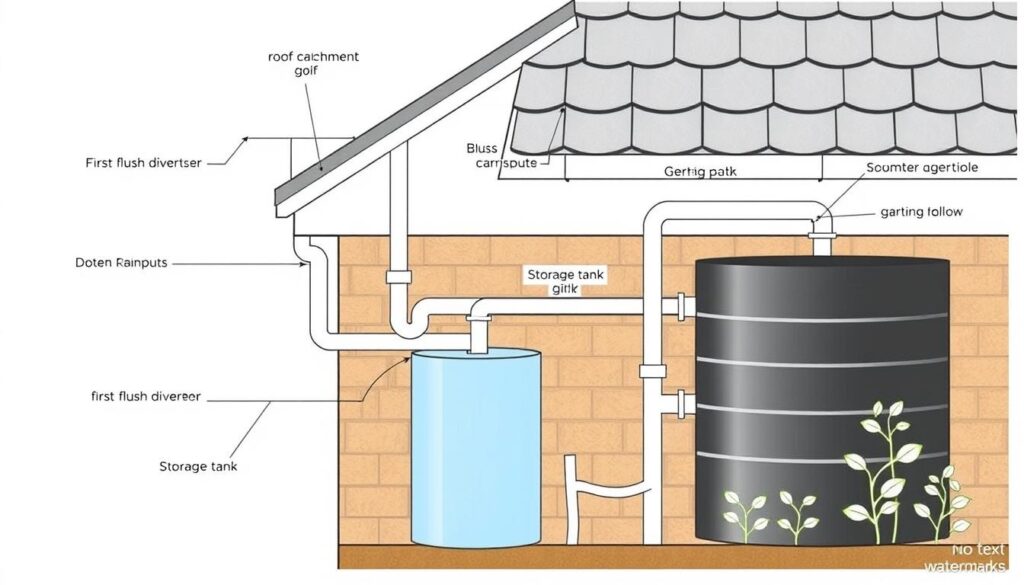
A complete rainwater harvesting system consists of several key components working together to collect, filter, store, and distribute water. Understanding each element will help you design an effective system for your garden in low-rainfall conditions:
1. Catchment Surface
The catchment surface is where rainwater is initially collected, typically a roof. Different roofing materials affect both the quantity and quality of water collected:
| Roof Type | Collection Efficiency | Water Quality Considerations |
| Metal | High (90-95%) | Excellent; minimal contaminants |
| Clay/Concrete Tiles | Medium (80-90%) | Good; some texture may trap debris |
| Asphalt Shingles | Medium (80-90%) | Fair; may leach residues (safe for garden use) |
| Wood Shingles | Low (75-80%) | Poor; potential contaminants |
In low-rainfall areas, maximizing collection efficiency is crucial. Metal roofs are ideal as they release water quickly without absorption and contain fewer contaminants. For existing asphalt roofs, implementing proper filtration becomes especially important.
2. Gutters and Downspouts
Gutters and downspouts channel water from the catchment surface to the storage system. In dry regions, proper sizing is essential to capture the occasional heavy rainfall events:
- Gutter Size: Standard 5-inch gutters are adequate for most residential applications, but 6-inch gutters are recommended for larger roof areas or regions with occasional intense storms.
- Downspout Sizing: Provide 1 square inch of downspout area for every 100 square feet of roof area. For example, a standard 2×3-inch downspout (6 square inches) can handle runoff from a 600-square-foot roof section.
- Installation Tips: Install gutters with a slight slope (1/16-inch per foot) toward downspouts. In low-rainfall areas, consider adding gutter guards to prevent debris buildup during long dry periods.
- Maintenance: Install gutter hangers every 3 feet to support the additional weight from occasional debris buildup.
3. Filtration System

Filtration is critical for removing debris and contaminants before water enters the storage tank. A multi-stage filtration approach works best:
Leaf Screens
The first line of defense against large debris, leaf screens are typically ¼-inch mesh screens installed over gutters or at downspout entrances. In low-rainfall areas where debris can accumulate during dry periods, regular cleaning is essential before the rainy season begins.
First Flush Diverters
First flush diverters are crucial in low-rainfall areas where long dry periods allow significant dust and contaminant buildup on roofs. These devices divert the initial flow of water (which contains the highest concentration of contaminants) away from the storage tank.
First Flush Calculation: For low-rainfall areas, divert a minimum of 10 gallons for every 1,000 square feet of collection surface for each inch of rainfall. In particularly dusty regions, consider increasing this to 15-20 gallons per 1,000 square feet.
Fine Filtration
For garden irrigation, especially drip systems, additional filtration prevents clogging of irrigation components:
- 30-50 micron filters: Suitable for general garden irrigation
- 5-10 micron filters: Recommended for drip irrigation systems
- DIY option: Homemade filters using air and dust vent filter material can be effective and economical
Storage Solutions for Low-Rainfall Areas
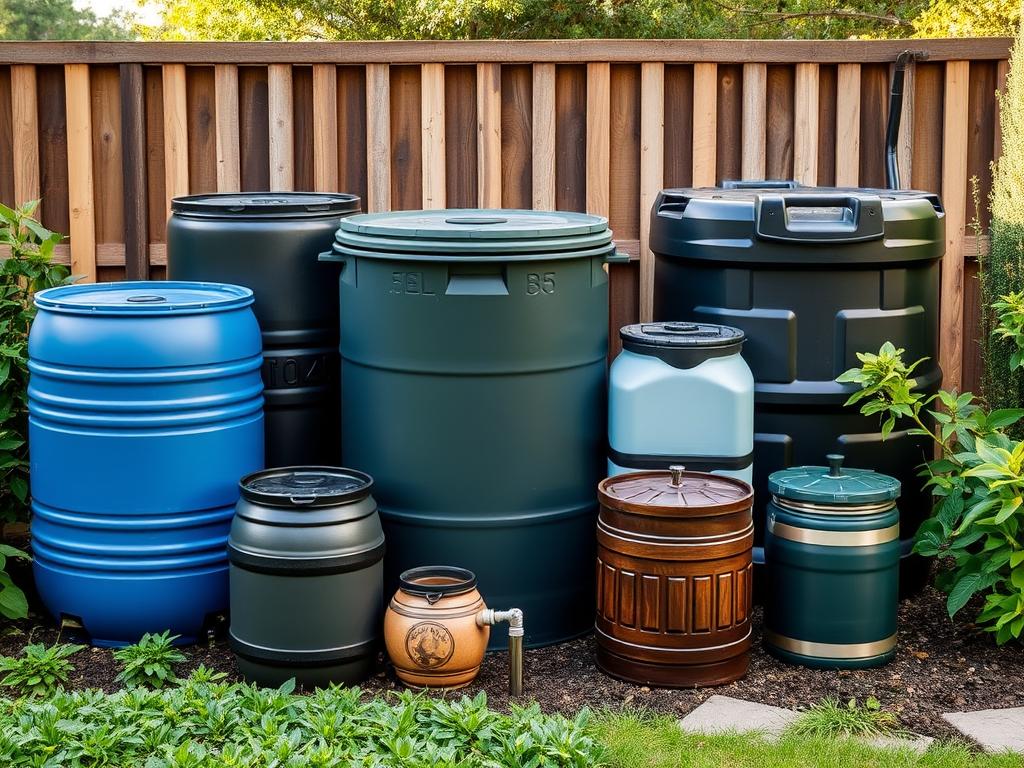
In low-rainfall regions, effective water storage is crucial for maximizing the benefit of infrequent rain events. Your storage solution should balance capacity needs with practical considerations:
Storage Container Options
| Container Type | Typical Capacity | Pros | Cons | Best For |
| Rain Barrels | 50-75 gallons | Affordable, easy to install, widely available | Limited capacity, multiple units needed for significant storage | Small gardens, beginners, limited space |
| Food-Grade Drums | 55 gallons | Inexpensive ($15-25), can be linked together | Requires modifications for connections | DIY systems, medium gardens |
| IBC Totes | 275-330 gallons | Excellent capacity-to-cost ratio, built-in spigot | Bulky, requires space, less attractive | Larger gardens, serious water harvesting |
| Cisterns | 500-5,000+ gallons | Maximum capacity, long-term storage | Higher cost, may require professional installation | Large properties, primary water source |
Sizing Your Storage System
In low-rainfall areas, determining the appropriate storage capacity is critical. Consider these factors:
Calculation Formula
To estimate potential rainwater collection:
Harvested rainwater (gallons) = Catchment area (ft²) × Rainfall depth (inches) × 0.62
For example, a 1,000 ft² roof in an area receiving 10 inches of annual rainfall could collect approximately 6,200 gallons per year.
Practical Considerations
- Garden water needs (typically 0.5-1 gallon per square foot per week during growing season)
- Duration of dry periods between rainfall events
- Available space for storage containers
- Budget constraints
Storage Tip for Low-Rainfall Areas: Rather than sizing for average conditions, consider sizing for drought scenarios. A good rule of thumb is to store enough water to cover at least 3-4 weeks of garden irrigation during the driest period of the year.
Storage Tank Placement and Preparation
Proper placement of storage tanks is crucial for system efficiency and longevity:
- Foundation: Place tanks on a level, stable surface. For larger tanks, consider a concrete pad or compacted gravel base.
- Elevation: When possible, elevate tanks to create gravity-fed pressure (2.31 feet of height creates 1 psi of pressure).
- Sun Protection: In hot, dry climates, shield tanks from direct sunlight to prevent algae growth and extend tank life.
- Accessibility: Ensure tanks are accessible for maintenance and cleaning.
- Overflow Direction: Direct overflow away from building foundations, septic systems, and erosion-prone areas.
Water Delivery Systems for Garden Irrigation
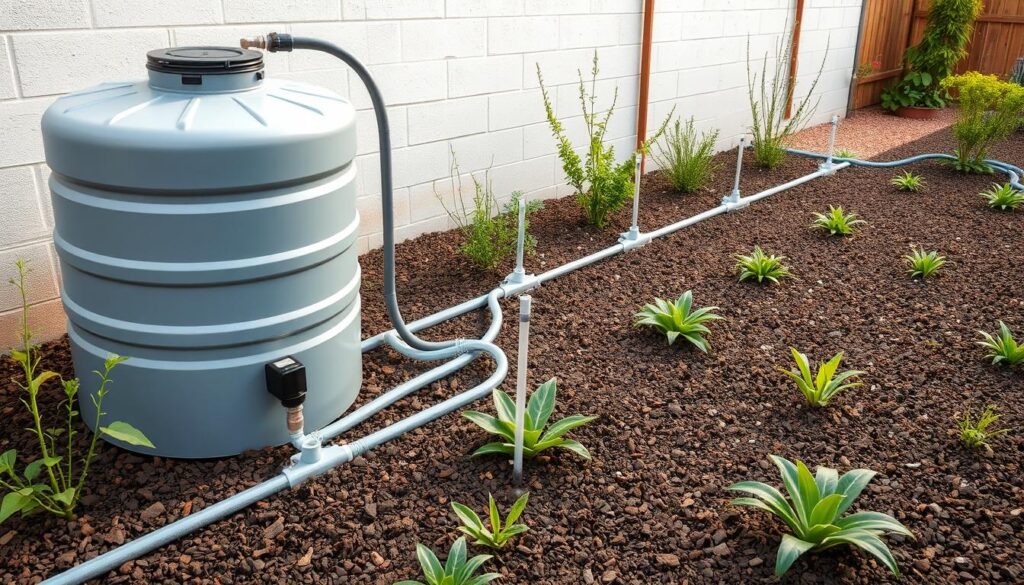
Once you’ve collected and stored rainwater, you need an efficient system to deliver it to your garden. In low-rainfall areas, maximizing water efficiency is paramount:
Gravity-Fed Systems
If your storage tanks are elevated above your garden area, gravity can provide free water pressure:
- Pressure Calculation: Water gains 1 psi of pressure for every 2.31 feet of vertical elevation.
- Practical Application: Most drip irrigation systems require at least 10-15 psi to function properly, meaning tanks should be elevated 23-35 feet above the garden for optimal performance.
- Realistic Solutions: For most home gardens, partial elevation (2-6 feet) can provide enough pressure for soaker hoses and gravity-fed drip systems with larger emitters.
Pump-Assisted Systems
When sufficient elevation isn’t possible, pumps can provide the necessary pressure:
Pump Types
- On-Demand Pumps: Activate automatically when a faucet is opened; ideal for intermittent use.
- Solar Pumps: Perfect for low-rainfall areas with abundant sunshine; eliminates electricity costs.
- Submersible Pumps: Placed inside the tank; quieter operation but more difficult to maintain.
- External Pumps: Easier to access for maintenance but require protection from the elements.
System Components
- Pressure Tank: Maintains consistent pressure and reduces pump cycling.
- Fine Filters: 5-micron filters protect pumps and irrigation components from clogging.
- Pressure Regulator: Prevents damage to drip irrigation components.
- Timers: Automate watering schedules for efficiency.
Irrigation Methods for Water Efficiency
In low-rainfall areas, choosing water-efficient irrigation methods is essential:
| Irrigation Method | Water Efficiency | Pressure Requirements | Best Applications |
| Drip Irrigation | 90-95% | 10-30 psi | Vegetables, perennials, shrubs |
| Soaker Hoses | 80-90% | 5-15 psi | Row crops, flower beds |
| Micro-Sprinklers | 75-85% | 15-30 psi | Ground covers, seedlings |
| Hand Watering | Varies (50-90%) | Minimal | Container plants, targeted watering |
Low-Pressure Drip Systems: For gravity-fed systems with limited pressure, look for specialized low-pressure drip irrigation components designed to operate at 10 psi or less. These typically feature larger emission holes that are less prone to clogging.
Maintenance and Troubleshooting
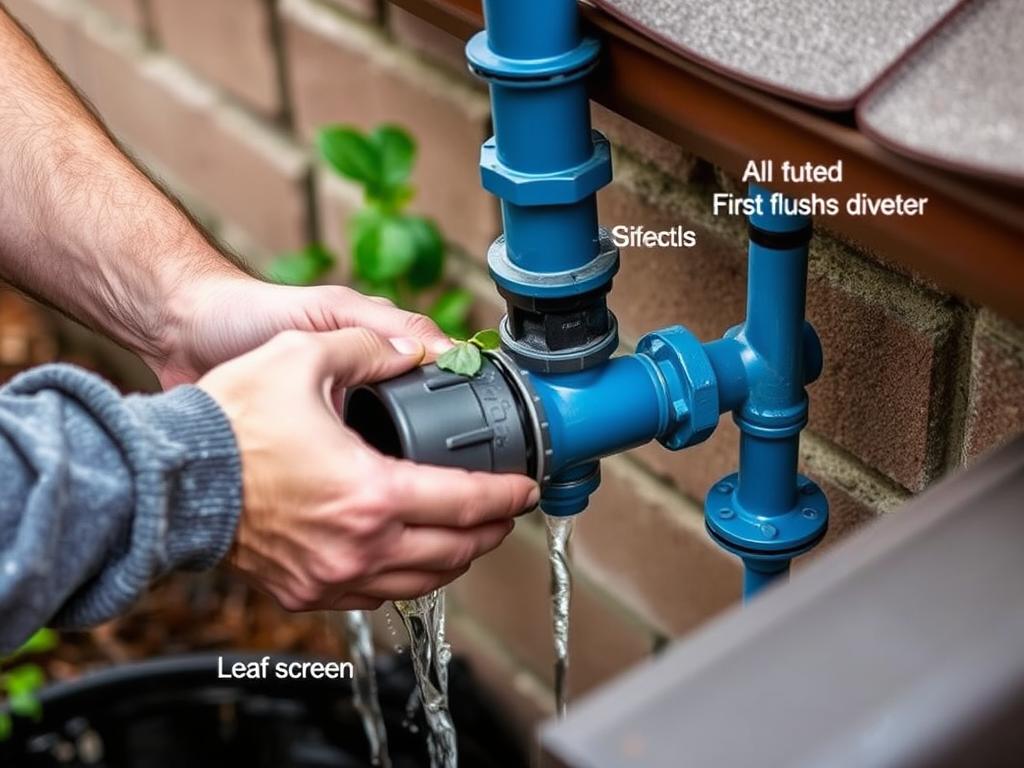
Regular maintenance is essential for keeping your rainwater harvesting system functioning efficiently, especially in low-rainfall areas where each drop counts:
Seasonal Maintenance Schedule
| Component | Maintenance Task | Frequency | Special Considerations for Dry Climates |
| Gutters & Downspouts | Clean debris, check for proper flow | Twice yearly and before expected rain | Critical before rainy season after long dry periods |
| Leaf Screens | Remove accumulated debris | Monthly during rainy season | Check before forecasted rain events |
| First Flush Diverter | Empty and clean | After each significant rainfall | Essential after dust storms |
| Filters | Clean or replace | Quarterly or when flow decreases | May need more frequent cleaning due to dust |
| Storage Tanks | Inspect for leaks, clean if necessary | Annually | Check for UV damage if exposed to sun |
| Pumps | Check operation, clean pre-filters | Quarterly | Protect from extreme heat |
Common Problems and Solutions
Water Quality Issues
- Algae Growth: Cover tanks to block sunlight or add food-grade hydrogen peroxide (1 tablespoon per 100 gallons).
- Mosquito Larvae: Ensure all openings are screened or add mosquito dunks containing BTI.
- Sediment Buildup: Improve pre-filtration or install a sediment trap at the tank bottom with a cleanout valve.
System Performance Issues
- Low Pressure: Check for clogged filters, increase tank elevation, or add a pump.
- Leaks: Regularly inspect connections, use thread tape on threaded fittings, and check for UV damage on exposed components.
- Overflow Problems: Ensure overflow pipes are properly sized and directed away from structures.
Winterizing Your System
Even in generally warm, low-rainfall areas, occasional freezing temperatures can damage system components:
- Drain Exposed Pipes: Empty all above-ground pipes and hoses when freezing temperatures are expected.
- Insulate Vulnerable Components: Wrap exposed valves and fittings with pipe insulation.
- Disconnect Pumps: If freezing temperatures are expected, disconnect and store pumps indoors.
- Maintain Water Level: Keep tanks at least half-full during winter to prevent damage from freezing and thawing cycles.
Maximizing Efficiency in Low-Rainfall Areas
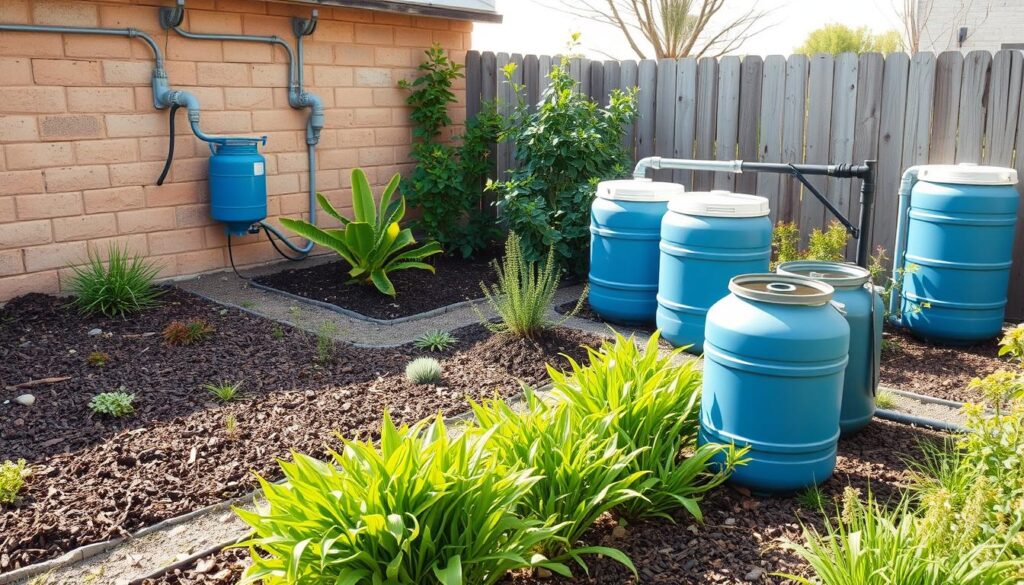
In regions with limited rainfall, implementing additional strategies alongside your rainwater harvesting system can dramatically increase your garden’s water efficiency:
Garden Design for Water Conservation
Plant Selection
- Choose drought-tolerant and native species adapted to local conditions
- Group plants with similar water requirements together (hydrozoning)
- Consider Mediterranean climate plants for low-rainfall areas
- Incorporate deep-rooted perennials that access moisture deeper in the soil
Soil Improvement
- Add organic matter to increase water retention capacity
- Use compost to improve soil structure and moisture-holding ability
- Consider water-retaining amendments like biochar in sandy soils
- Maintain healthy soil biology to improve water efficiency
Mulching Strategies
Mulching is particularly critical in low-rainfall areas, reducing evaporation by up to 70%:
| Mulch Type | Water Conservation Effectiveness | Longevity | Best Applications |
| Wood Chips | High | 1-3 years | Perennial beds, trees, shrubs |
| Straw | Medium-High | 3-6 months | Vegetable gardens, annual beds |
| Gravel/Stone | Medium | 5+ years | Drought-tolerant landscapes, pathways |
| Compost | Medium | 6-12 months | Vegetable gardens, annual beds |
Apply mulch 2-4 inches deep, keeping it away from plant stems and tree trunks to prevent rot. Refresh mulch as needed to maintain its water conservation benefits.
Passive Water Harvesting Techniques
Complement your active rainwater collection with passive techniques that slow, spread, and sink water directly in the landscape:
- Swales: Shallow, level-bottomed ditches that follow land contours to capture and infiltrate runoff
- Berms: Raised earth mounds that direct and contain water flow
- Rain Gardens: Planted depressions that capture runoff from impervious surfaces
- Infiltration Basins: Larger depressions designed to hold water until it percolates into the soil
- Terracing: Level platforms cut into slopes to reduce runoff and erosion
Soil as Storage: Well-amended soil can store significant amounts of water. Each 1% increase in organic matter can increase water-holding capacity by approximately 16,000 gallons per acre-foot of soil.
Case Study: Small-Scale Rainwater Harvesting in Arizona
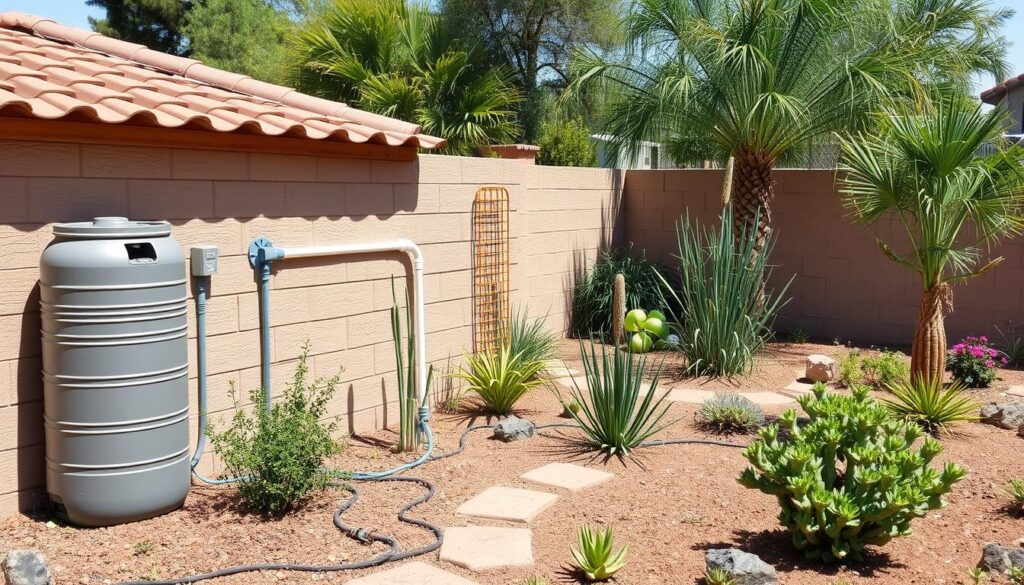
Maria, a homeowner in Tucson, Arizona, implemented a rainwater harvesting system to support her 400-square-foot vegetable and herb garden in an area receiving just 12 inches of annual rainfall. Her experience provides valuable insights for gardeners in similar low-rainfall regions:
System Components
- Catchment: 800-square-foot metal roof section
- Storage: Three connected 275-gallon IBC totes (825 gallons total)
- Filtration: Leaf screens, first flush diverter, and 30-micron filter
- Delivery: Solar-powered pump with pressure tank and drip irrigation
- Supplemental: Small swales and berms to capture additional runoff
Results and Lessons
Water Collection
- Annual collection: Approximately 5,000 gallons
- Covered 70% of garden water needs
- Reduced municipal water use by 60%
- Provided water security during restrictions
Key Insights
- System paid for itself in water savings within 3 years
- Plants showed improved health with rainwater vs. municipal water
- Seasonal adjustments to irrigation timing maximized efficiency
- Regular maintenance was essential for system performance
“Even in our desert climate, I was surprised by how much water we could collect from our roof. The key was having adequate storage to capture the occasional heavy monsoon rains and then use that water gradually during dry periods. The improved plant health and reduced water bills made the initial investment worthwhile.”
Adaptations for Extreme Drought
During an exceptionally dry year with only 8 inches of rainfall, Maria implemented these additional strategies:
- Added shade cloth over sensitive crops to reduce evaporation
- Implemented ollas (unglazed clay pots) for subsurface irrigation
- Increased mulch depth from 2 to 4 inches
- Prioritized water for high-value and perennial plants
- Captured and reused household greywater as a supplement
Resources and Next Steps
Ready to Start Harvesting Rainwater?
Download our free Rainwater Harvesting Calculator and Planning Guide to determine your potential collection capacity and design a system tailored to your specific needs.
Local Resources
Many regions offer resources and incentives for rainwater harvesting:
- Contact your local Cooperative Extension office for region-specific advice
- Check with your water utility for potential rebates or incentives
- Look for local workshops on rainwater harvesting techniques
- Connect with community gardening groups for shared knowledge
Recommended Reading
- “Rainwater Harvesting for Drylands and Beyond” by Brad Lancaster
- “The Texas Manual on Rainwater Harvesting” by the Texas Water Development Board
- “Create an Oasis with Greywater” by Art Ludwig
- “Water Storage: Tanks, Cisterns, Aquifers, and Ponds” by Art Ludwig
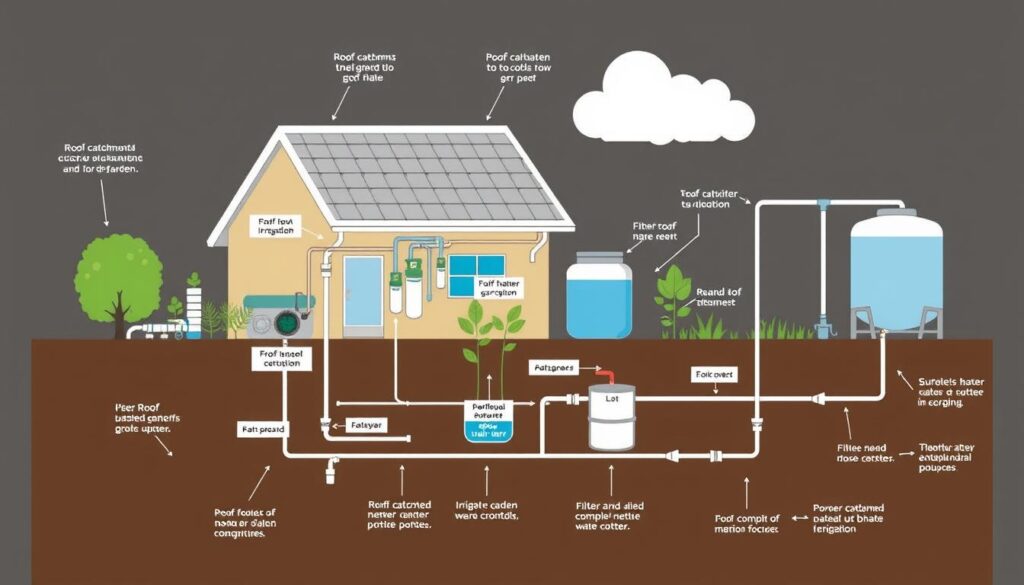
Conclusion
Rainwater harvesting represents one of the most effective strategies for maintaining productive gardens in low-rainfall areas. By capturing, storing, and efficiently using this precious resource, you can create resilient garden systems that thrive even in challenging conditions. The initial investment in time and materials pays dividends through reduced water bills, healthier plants, and environmental benefits.
Remember that successful rainwater harvesting in dry regions requires a holistic approach. Combine your collection system with appropriate plant selection, soil improvement, efficient irrigation, and thoughtful garden design. Start with a system that matches your current needs and budget, with the flexibility to expand as you gain experience and confidence.
Every drop of rainwater you harvest is a step toward greater self-sufficiency and sustainability in your garden. In regions where water is increasingly precious, becoming a steward of this resource is both an environmental responsibility and a practical necessity for successful gardening.
Share Your Rainwater Harvesting Experience
Have you implemented a rainwater harvesting system in a low-rainfall area? We’d love to hear about your experiences, challenges, and successes. Join our community forum to connect with other water-conscious gardeners.
Will is a vertical gardening enthusiast and sustainable cultivation specialist with a passion for helping people grow fresh food in small spaces and dry climates. With years of hands-on experience testing smart irrigation systems, optimizing urban gardens, and exploring eco-friendly solutions, this author shares clear, practical tips to turn any corner into a productive garden. Whether on a sunny balcony or in a compact backyard, Will helps readers save water, maximize space, and enjoy healthy harvests year-round. When not tending to his plants, you’ll find him sipping herbal tea and sketching ideas for new sustainable projects.

